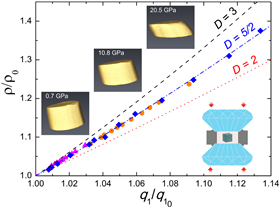A universal fractional noncubic power law for density in metallic glasses - Dr. Qiaoshi Zeng
Metallic glass is a new class of glass showing unique properties compared with conventional materials, e.g. extremely high strength, extraordinary hardness, superior wear resistance and corrosion resistance, excellent soft magnetic properties and high flexibility at high temperature. These properties are critical for structural, magnetic and chemical applications. Thus, metallic glasses are currently at the focus of intense research efforts worldwide.
Unlike its ordered crystalline counterpart that follows strict, well-defined rules and symmetry in their atomic packing, amorphous metallic glass is disordered at the atomic scale and constrained by few rules. Research has been limited to analyzing local clusters without the guidance of any general laws connecting the microscopic descriptions and bulk properties.
By developing and utilizing state-of-the-art in situ high pressure synchrotron x-ray techniques including 3-dimensional x-ray tomography, x-ray ultrasonic sound velocity and x-ray diffraction measurements, the macroscopic properties (density) and atomic level structure information (interatomic spacing) were precisely correlated, it is surprisingly found that the three-dimensional density of metallic glasses is not simply the cube of their one-dimensional average interatomic spacing, but varies with a 5/2 fractional power. Moreover, the counter-intuitive, non-cubic 5/2 power law is universally and strictly followed by a number of metallic glasses tested, thus establishing a fundamental rule for the microscopic-macroscopic relations of metallic glass.

Figure caption: The relative density change (ρ/ρ0) as functions of the relative principle peak position change (q1/q10) of three bulk metallic glass samples, La62Al14Cu11.7Ag2.3Ni5Co5 (blue diamonds), La62Al14Co10.83Ni10.83Ag2.34 (orange circles) and Cu47Ti33Zr11Ni8Nb1 (magenta triangles). The lines represent the relationship to guide the eye with different power values D, D = 3 (black dashed line), D = 2.5 (blue dash-dotted line), D = 2 (red dotted line). Three samples follow the 5/2 power law very well. The gray zone represents the region with D = 2.5±0.1.
This discovery provides a critical constraint for the glass structure modeling, thus helps us to understand the real atomic packing of metallic glasses and eventually design new metallic glass materials at the atomic level with tailored properties. Meanwhile, it is also important for correcting and guiding the practical in situ measurements of density under various environments or any other measurements involving changes in length scale in metallic glasses. This work was published in Physical Review Letters.
Link to the paper published on PRL:
http://journals.aps.org/prl/abstract/10.1103/PhysRevLett.112.185502
